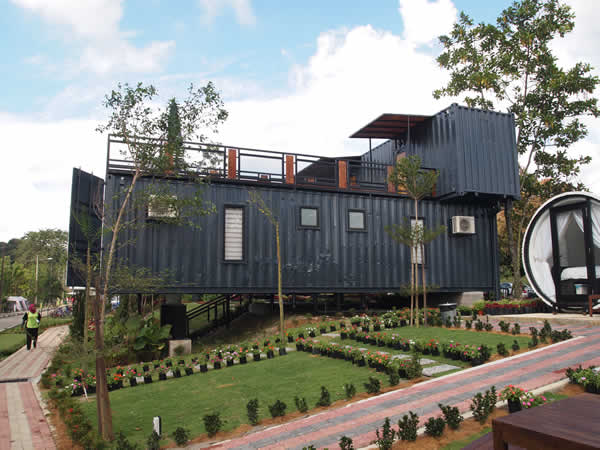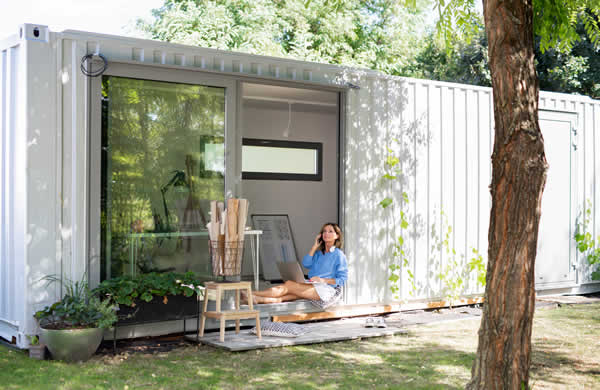As the prices of traditional homes are getting higher every year, innovators and future homeowners are trying to find affordable alternatives. One of the most popular options is a shipping container home.

Container homes provide an excellent solution to cost-effective housing. Since the shipping container itself serves as the structure for the home, it’s preferred by DIY home builders. However, there are some advantages and disadvantages you have to consider.
That said, here’s a comprehensive guide to understanding the pros and cons of container homes.
Floor Area And Layout
In terms of floor area and layout, shipping containers are flexible. They can be modified, stacked, and attached side-by-side. However, they may also restrict your creative ideas of a dream home.
Pros
Container homes are easy to customize according to your needs. You can find available floor plans and design inspirations online, making them DIY-friendly. Shipping containers are 20 ft and 40 ft. in length, which can be combined or stacked depending on your plan.
Moreover, readily modified shipping containers are available in some regions. Some tiny house builders offer ready-made container homes with efficient floor plans, which you can directly ship to your chosen location.
Cons
One of the disadvantages of container homes is the limited floor space. Each shipping container is only 2.4 meters wide and may be reduced to 2.2 meters depending on the insulation’s thickness. For some, a container home’s width may feel claustrophobic. To widen the space, some builders combine two or three shipping containers.
Durability
Every home should be durable and structurally sound. Shipping containers are known for their structural integrity and resistance to weather. However, the modification may affect the overall strength. Here are some notable details.
Pros
Shipping containers are made with corrosion-resistant steel. They can withstand moisture and extreme weather conditions. The container’s corrugated walls and rigid corners make them perfect for stacking.
Cons
While shipping containers are structurally tough, the modifications to make them livable call for additional reinforcement. As you cut out walls for doors and windows, the structure weakens. Therefore, you might need to add steel posts or beams to maintain its shape and ensure your safety.
Total Cost To Build
Shipping container homes are known as an affordable housing alternative. However, the cost of building a home is relative to different factors such as design, choice of materials, labor, and location.
Pros
Container homes are usually less expensive than traditional homes, especially in New Zealand and Australia. You can also save more if you buy used shipping containers instead of new ones.
Another way to reduce the cost of building a container home is to DIY it. However, it’s still best to hire professionals, especially for electrical and plumbing.
Cons
In some regions, container homes may cost more than traditionally-built ones. Some factors are the availability of shipping containers, materials, and logistics. Knowing the prices in your location is imperative to weigh which is cheaper. Moreover, high-end container homes can also cost as much as traditional homes. Like any building type, the prices of materials significantly impact the total cost to build.
Time To Build
Building your dream home may take some time. A traditional build may take up to 10 months, depending on the gross floor area. Creating a shipping container home may take from 4 to 10 weeks, especially if you’re buying from a trusted tiny house builder.
Pros
Shipping container homes are generally faster to build. Since the structure is already there, you can immediately start cutting out holes for doors and windows and building frames for wall cladding and ceiling. When you buy a ready-built shipping container home, you only have to modify the floor plan if needed.
Cons
In some locations, it’s harder to find contractors specializing in container homes. Searching for one or doing it yourself may take more time than building a house from scratch. Plus, complex architectural designs may take longer to build, especially those that require more structural reinforcements.
Eco-Friendliness
Sustainability is one of the goals of building modern homes. Reducing the impact of a build on the environment is the key to lessening carbon footprint. For homeowners, choosing eco-friendly building materials is a responsible act.
Pros
In terms of eco-friendliness, container homes are some of the top choices. Since shipping containers are often left in junkyards to rot after several uses, repurposing them is an excellent innovation. When you buy a container to make it your home, you’re giving it a new life. Furthermore, container homes don’t require large posts for the foundation. They can also be built on wheels for transportability.
Cons
Some container homes aren’t as eco-friendly as some may think. Some builders and homeowners choose brand new shipping containers for their homes. In this case, the goal of recycling and repurposing is not met.

Conclusion
Shipping container homes are a flexible and affordable solution for housing. When considering building or owning one, understanding all the pros and cons is a must.
